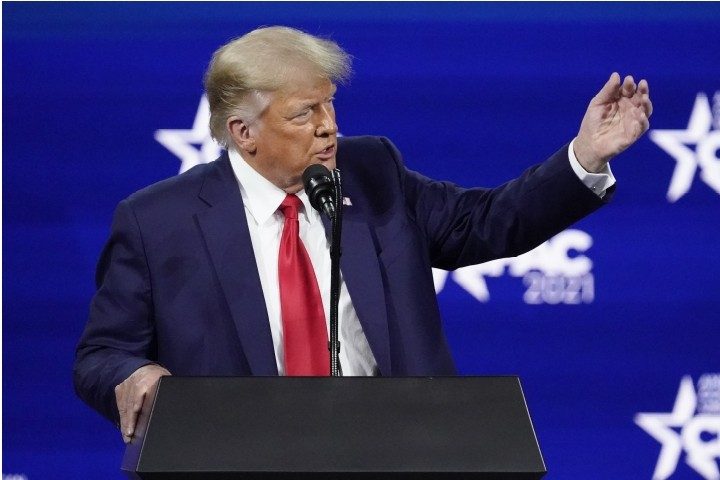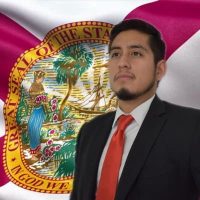
On the road outside Orlando’s Hyatt Regency hotel, hundreds of exuberant conservatives lined the sidewalk bearing Trump signs, waving Trump flags, and sporting Trump hats and Trump-themed t-shirts as the crowd engaged in ecstatic chants in eager anticipation of the 45th American president’s arrival Sunday to deliver the closing speech at the annual Conservative Political Action Conference, or CPAC.
The environment inside wasn’t much different. A common theme tied together the various speeches and panels that took place during the conservative movement’s four-day equivalent of the Super Bowl: An unabashed dedication to the principles espoused by President Donald Trump.
On Friday, Florida Governor Ron DeSantis declared that “we cannot, we will not, go back to the days of the failed Republican establishment of yesteryear. We reject open borders and instead support American sovereignty and the American worker. Building a movement on amnesty and cheap foreign labor is like building a house on a field of quicksand.”
Later the same day, Senator Rick Scott (R-Fla.), Florida’s former governor, likewise railed against open borders, while Senator Josh Hawley (R-Mo.) spoke of “oligarchs” using mass migration, Big Tech censorship, and the offshoring of American jobs to make the country poorer and less free.
President Trump himself openly took shots at Senate Minority Leader Mitch McConnell (R-Ky.) and, in one of the highlights of his speech, named a list of “grandstanders” in the House and Senate who voted to impeach and convict him, insinuating that they should be defeated by primary challengers even as he confirmed reports that he is vetting candidates whom he will endorse and financially back against establishment incumbents.
“It has just been stated that President Trump’s endorsement is the most powerful asset in politics,” Trump declared. And it’s hard to argue against that statement.
Establishment and anti-Trump figures such as McConnell, Senator Romney (R-Utah), And Representative Liz Cheney (R-Wyo.) didn’t dare show their faces at the conference. Meanwhile, the new wave of Trump-aligned members of Congress, such as Representatives Lauren Boebert (R-Colo.) and Madison Cawthorn (R-N.C.), along with pro-Trump state officials such as South Dakota Governor Kristi Noem, were followed around by hordes of conservative fans hoping for an opportunity to get a picture and autograph.
Representative Marjorie Taylor Greene (R-Ga.), the embattled congresswoman who was stripped of committee work for allegedly violent statements, and who filed articles of impeachment against Joe Biden, was apparently deemed too extreme by decision-makers at CPAC to warrant an invitation to speak.
But she was, nevertheless, present at the conference’s halls as an attendee, and was just as positively received by the crowd as any of the aforementioned icons — a testament both to the conservative public’s desire for audacious representatives and to its disregard for the smear tactics of the mainstream media.
And if there was ever any doubt about who most conservatives in America consider the movement’s political leader, few moments garnered as much applause as when President Trump promised that “a Republican president will make a triumphant return to the White House.”
“And I wonder who that will be?” Trump asked. “I wonder who that will be? Who, who, who will that be? I wonder.”
The last months have been marked by a struggle for the soul of the Republican Party, with the establishment, including McConnell and Senate Minority Whip John Thune (R-S.D.), vowing to purge the GOP of Trumpism. Thune even said he will aid establishment incumbents facing MAGA challengers, placing him on a collision course with President Trump.
But a look at the CPAC crowd shows that, at least when it comes to the fight for the heart of voters, the battle is over, with Donald Trump winning overwhelmingly.
Curiously, among the documentaries played on the televisions situated throughout the hallways at CPAC was one detailing National Review founder William F. Buckley’s decades-old crusade against the John Birch Society, depicting him as a hero for “purging” the conservative movement years ago of “conspiracy theorists” who believed in the Deep State, opposed the United Nations, and who warned of the growing threat of communist China.
Now, decades later, the roles are reversed. The “conspiracy theorists,” now called the America First movement, are the mainstream — while the bowtie-wearing establishment conservative pundits have become the irrelevant fringe.




